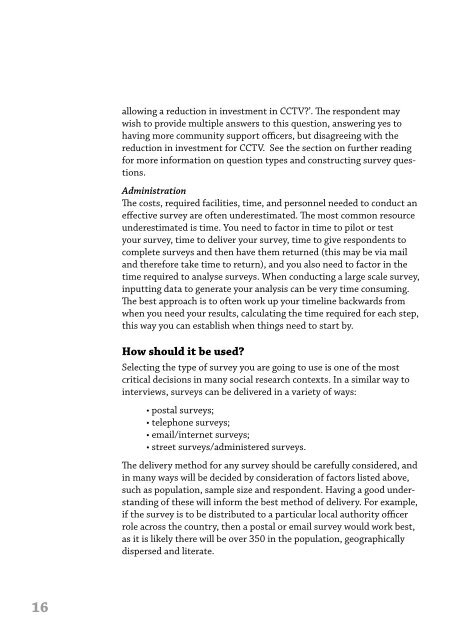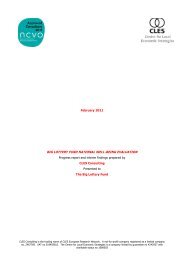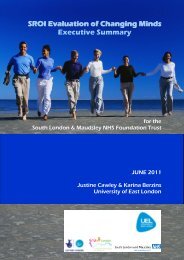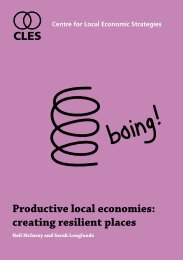Research Methods Handbook.pdf - CLES
Research Methods Handbook.pdf - CLES
Research Methods Handbook.pdf - CLES
Create successful ePaper yourself
Turn your PDF publications into a flip-book with our unique Google optimized e-Paper software.
allowing a reduction in investment in CCTV?’. The respondent maywish to provide multiple answers to this question, answering yes tohaving more community support officers, but disagreeing with thereduction in investment for CCTV. See the section on further readingfor more information on question types and constructing survey questions.AdministrationThe costs, required facilities, time, and personnel needed to conduct aneffective survey are often underestimated. The most common resourceunderestimated is time. You need to factor in time to pilot or testyour survey, time to deliver your survey, time to give respondents tocomplete surveys and then have them returned (this may be via mailand therefore take time to return), and you also need to factor in thetime required to analyse surveys. When conducting a large scale survey,inputting data to generate your analysis can be very time consuming.The best approach is to often work up your timeline backwards fromwhen you need your results, calculating the time required for each step,this way you can establish when things need to start by.How should it be used?Selecting the type of survey you are going to use is one of the mostcritical decisions in many social research contexts. In a similar way tointerviews, surveys can be delivered in a variety of ways:• postal surveys;• telephone surveys;• email/internet surveys;• street surveys/administered surveys.The delivery method for any survey should be carefully considered, andin many ways will be decided by consideration of factors listed above,such as population, sample size and respondent. Having a good understandingof these will inform the best method of delivery. For example,if the survey is to be distributed to a particular local authority officerrole across the country, then a postal or email survey would work best,as it is likely there will be over 350 in the population, geographicallydispersed and literate.It is vitally important to conduct a trial run or pilot of any survey, asthose that have designed a survey and are close to its subject, may takefor granted that the questions and layout will work as a survey with thewider intended population. A survey may be piloted with colleagues orfriends that have the same level of involvement in the subject you aresurveying as the wider intended population. Feedback should be soughton the ease upon which the survey can be followed and completed. A pilotsurvey may also be conducted with a subset of the selected sample.This would give opportunities to detect and resolve problems beforethey obscure or distort the result of the wider survey.ProsConsPostal Can reach a large geographical area No clarification available duringcompletion.Telephone/administeredPeople are used to completingpaper-and-pencil surveysCan take the survey with you andcomplete it anywhere and anytimeGreat for sensitive issuesInformation is obtained immediatelyCan explore answers withrespondentsNeed a motivated population toreturn the surveyRespondents must be able to read,see, and writePossible bias from theadministratorHigher level of resourcesemail/internet Negligible distribution costs Respondent must be “online”Only “acceptable” answers can beallowed (validation)Require the question to beansweredCan give respondent links that giveadditional explanationRespondents must be able touse a computer, a mouse, and/orkeyboardRespondent must be able to use aweb browserReliant on technology that can fail16 17









